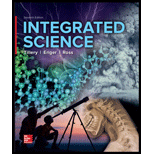
Integrated Science
7th Edition
ISBN: 9780077862602
Author: Tillery, Bill W.
Publisher: Mcgraw-hill,
expand_more
expand_more
format_list_bulleted
Concept explainers
Question
Chapter 12, Problem 9CQ
To determine
The meaning of the main sequence of the H-R diagram and the thing that determines the place, a star can be plotted on the main sequence.
Expert Solution & Answer
Want to see the full answer?
Check out a sample textbook solution
Students have asked these similar questions
Need help wity equilibrium qestion
need answer asap please thanks you
A man slides two boxes up a slope. The two boxes A and B have a mass of 75 kg and 50
kg, respectively.
(a) Draw the free body diagram (FBD) of the two crates.
(b) Determine the tension in the cable that the man must exert to cause imminent
movement from rest of the two boxes.
Static friction coefficient
USA = 0.25
HSB = 0.35
Kinetic friction coefficient
HkA = 0.20
HkB = 0.25
M₁ = 75 kg
MB = 50 kg
P
35°
Figure 3
B
200
Chapter 12 Solutions
Integrated Science
Ch. 12.1 - Stars twinkle and planets do not twinkle because...Ch. 12.6 - Prob. 2SCCh. 12.6 - Prob. 3SCCh. 12.6 - Prob. 4SCCh. 12.6 - Prob. 5SCCh. 12.6 - Prob. 6SCCh. 12.6 - Prob. 7SCCh. 12.6 - Prob. 8SCCh. 12.7 - Prob. 9SCCh. 12.7 - Prob. 10SC
Ch. 12.7 - Prob. 11SCCh. 12.7 - Prob. 12SCCh. 12 - What is a light-year, and how is it defined?Ch. 12 - Prob. 2CQCh. 12 - Prob. 3CQCh. 12 - What is the Hertzsprung-Russell diagram?Ch. 12 - Prob. 5CQCh. 12 - Prob. 6CQCh. 12 - Prob. 7CQCh. 12 - Prob. 8CQCh. 12 - Prob. 9CQCh. 12 - Prob. 10CQCh. 12 - Prob. 11CQCh. 12 - Prob. 12CQCh. 12 - Prob. 13CQCh. 12 - Prob. 14CQCh. 12 - Prob. 15CQCh. 12 - Prob. 16CQCh. 12 - Prob. 17CQCh. 12 - Prob. 18CQCh. 12 - Prob. 19CQCh. 12 - Prob. 20CQCh. 12 - Prob. 21CQCh. 12 - Prob. 22CQCh. 12 - Analyze when apparent magnitude is a better scale...Ch. 12 - Prob. 24CQCh. 12 - Prob. 25CQCh. 12 - Prob. 1PEACh. 12 - Prob. 2PEACh. 12 - Prob. 3PEACh. 12 - Prob. 4PEACh. 12 - Prob. 5PEACh. 12 - Prob. 6PEACh. 12 - Prob. 7PEACh. 12 - Prob. 8PEACh. 12 - Prob. 9PEACh. 12 - Prob. 10PEACh. 12 - Prob. 11PEACh. 12 - Prob. 1PEBCh. 12 - Prob. 2PEBCh. 12 - Prob. 3PEBCh. 12 - Prob. 4PEBCh. 12 - Prob. 5PEBCh. 12 - Prob. 6PEBCh. 12 - Prob. 7PEBCh. 12 - Prob. 8PEBCh. 12 - Prob. 9PEBCh. 12 - Prob. 10PEBCh. 12 - Prob. 11PEB
Knowledge Booster
Learn more about
Need a deep-dive on the concept behind this application? Look no further. Learn more about this topic, physics and related others by exploring similar questions and additional content below.Similar questions
- A golf ball is struck with a velocity of 20 m/s at point A as shown below (Figure 4). (a) Determine the distance "d" and the time of flight from A to B; (b) Determine the magnitude and the direction of the speed at which the ball strikes the ground at B. 10° V₁ = 20m/s 35º Figure 4 d Barrow_forwardThe rectangular loop of wire shown in the figure (Figure 1) has a mass of 0.18 g per centimeter of length and is pivoted about side ab on a frictionless axis. The current in the wire is 8.5 A in the direction shown. Find the magnitude of the magnetic field parallel to the y-axis that will cause the loop to swing up until its plane makes an angle of 30.0 ∘ with the yz-plane. Find the direction of the magnetic field parallel to the y-axis that will cause the loop to swing up until its plane makes an angle of 30.0 ∘ with the yz-plane.arrow_forwardA particle with a charge of − 5.20 nC is moving in a uniform magnetic field of (B→=−( 1.22 T )k^. The magnetic force on the particle is measured to be (F→=−( 3.50×10−7 N )i^+( 7.60×10−7 N )j^. Calculate the y and z component of the velocity of the particle.arrow_forward
- Pls help ASAParrow_forwardPls help ASAParrow_forward9. When an electron moves into a uniform and perpendicular magnetic field, it will.. a. Accelerate parallel to the magnetic Field until it leaves b. Accelerate in a circular path c. Accelerate perpendicular to both the magnetic field and its original direction d. Repel back into the electric field 10. If a proton at rest is placed in a uniform magnetic field with no electric or gravitational field around, the proton will…….. a. Accelerate in the direction of the magnetic field b. Accelerate in a direction perpendicular to the magnetic field c. Move in a circular path d. Not acceleratearrow_forward
arrow_back_ios
SEE MORE QUESTIONS
arrow_forward_ios
Recommended textbooks for you
 Stars and Galaxies (MindTap Course List)PhysicsISBN:9781337399944Author:Michael A. SeedsPublisher:Cengage Learning
Stars and Galaxies (MindTap Course List)PhysicsISBN:9781337399944Author:Michael A. SeedsPublisher:Cengage Learning Foundations of Astronomy (MindTap Course List)PhysicsISBN:9781337399920Author:Michael A. Seeds, Dana BackmanPublisher:Cengage Learning
Foundations of Astronomy (MindTap Course List)PhysicsISBN:9781337399920Author:Michael A. Seeds, Dana BackmanPublisher:Cengage Learning AstronomyPhysicsISBN:9781938168284Author:Andrew Fraknoi; David Morrison; Sidney C. WolffPublisher:OpenStax
AstronomyPhysicsISBN:9781938168284Author:Andrew Fraknoi; David Morrison; Sidney C. WolffPublisher:OpenStax Horizons: Exploring the Universe (MindTap Course ...PhysicsISBN:9781305960961Author:Michael A. Seeds, Dana BackmanPublisher:Cengage Learning
Horizons: Exploring the Universe (MindTap Course ...PhysicsISBN:9781305960961Author:Michael A. Seeds, Dana BackmanPublisher:Cengage Learning Stars and GalaxiesPhysicsISBN:9781305120785Author:Michael A. Seeds, Dana BackmanPublisher:Cengage Learning
Stars and GalaxiesPhysicsISBN:9781305120785Author:Michael A. Seeds, Dana BackmanPublisher:Cengage Learning

Stars and Galaxies (MindTap Course List)
Physics
ISBN:9781337399944
Author:Michael A. Seeds
Publisher:Cengage Learning

Foundations of Astronomy (MindTap Course List)
Physics
ISBN:9781337399920
Author:Michael A. Seeds, Dana Backman
Publisher:Cengage Learning

Astronomy
Physics
ISBN:9781938168284
Author:Andrew Fraknoi; David Morrison; Sidney C. Wolff
Publisher:OpenStax

Horizons: Exploring the Universe (MindTap Course ...
Physics
ISBN:9781305960961
Author:Michael A. Seeds, Dana Backman
Publisher:Cengage Learning

Stars and Galaxies
Physics
ISBN:9781305120785
Author:Michael A. Seeds, Dana Backman
Publisher:Cengage Learning
